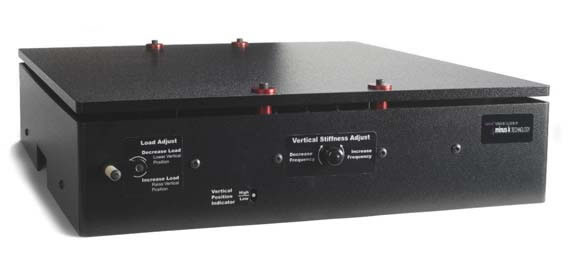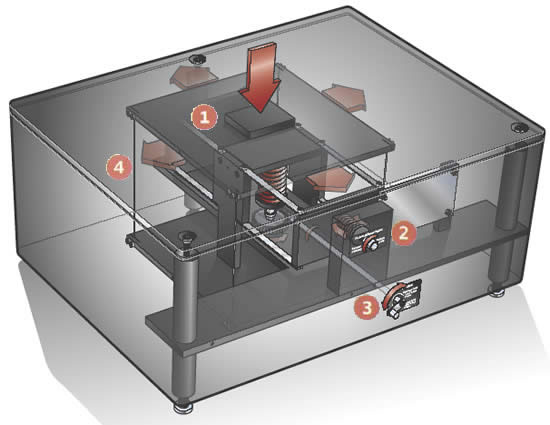
Positive Feedback Online - January/February 2014
Impressions: Notes on the Minus K Technology 100BM-8
High-throughput CMM laser interferometry surface measurement systems can be negatively affected by plant low-frequency vibrations, which can distort the interferometry measurements and deliver inaccurate readings. Here's how to prevent that from happening. By Robyn Schmitt.

It has been a long while since I wrote about a vibration isolation platform. In fact, I would have to go back to the days of the Vibraplane Model 2210 passive platform's arrival here at Clark Johnsen's strong recommendation to find the last time that I did this. And that takes it back to the later '90s… a while back now. He was right… it was really good, much better than the early Townshend stands that I had at that time…and I ended up purchasing the review sample. The world has changed in a lot of ways since then, while my trusty Vibraplane 2210 has continued to do its work without a problem over the years. It's a bloody heavy beastie, but I don't shift it around too much, and so it's been on the top shelf of my Michael Green Justarack, another trusty-rusty, since then.
Wow. That is a long time.
Since then, I've mainly covered rack systems, with some excellent designs from Walker Audio and Critical Mass Systems. I had a rack from Grand Prix Audio in at one point, as well. Then, just recently, Bruce Jacobs of Stillpoints installed two of the Stillpoints ESS isolation racks here for review… my comments will be forthcoming in 2014. But that's been it. I hadn't thought about re-approaching the question of isolation platforms for a long time.
But…………….last year I was approached by Minus K, a company that makes high-quality isolation platforms for various markets, including highly sophisticated electron microscopes and other very sensitive sensory gear (see the Minus site for more details on the company and its product lines). At first, I didn't remember the company, and told them that I wasn't interested. They persisted, reminding me that Dave Glackin had written a glowing review about their isolation products in our print days, which I then re-printed all the way back in PFO Issue 1 (!!).
Well now…that's different! Anything that Dave, my late-and-much-lamented audiobud, recommended that highly was worth a listen. And so, in memory of Dave, I asked Minus K to send along the BM-8 for a spin. I'd see how the current product measured up…bring it on.
The Product and the Setup Thereof
The impressive theory and design behind the Minus K product line is well beyond the scope of this article. I do know that Dave Glackin had spoken with great appreciation about Dr. David L. Platus, the design engineer behind the company, and the fact that he had the engineering credentials that Dave loved to see, putting real physics behind the isolation devices that he was producing. For those readers interested in reading more about the technical layers of the product, check out the Minus K site for a handful of very helpful animated presentations on the design considerations involved. In sum, the Minus K platforms employ ingenious "negative stiffness" technology in a multi-layer isolation system to reduce environmentally-transmitted vibration to a minimum. The technical presentation animations help to illustrate the concepts; I recommend that you read these if you want to know more about the way that Minus K isolation platforms work.
I'll concentrate on the empirical audio performance.
By the time the Minus K system arrived, I had received the brilliant MBL Reference System, with the 1611F high-resolution PCM (only) DAC and 1621A CD transport. I had placed the 1621A transport on the Vibraplane, where I had obtained satisfactory results of the kind that I was used to. Much better sound than with just the Justarack, for sure. With the arrival of the 50BM-8, the time had come for the substitution. I didn't do this lightly… no pun intended.
Our first go at it didn't go so well. I got the 1611A off… no little matter, it weighing well over 50 pounds…followed by the approximately 150 pound (damnation!) Vibraplane off of the top shelf. Doing this by myself was a major task…no injuries, I'm glad to say. Up went the 50BM-8, and then I followed the deployment notes for setup and adjustment. Having done that, I placed the MBL 1621A transport on the Minus K platform, and began the final fine-tuning, according to the documentation. Simple, right?
Huh!
The 50BM-8 simply wouldn't setup…it wouldn't hoist the weight of the 1621A. I couldn't figure it out, and finally had to call Minus K for some help. Within moments the good folks there located the problem. Unfortunately, I had specified the wrong model for the weight of a component like the 1621A transport. When I had discussed the project with Minus K, I didn't realize quite how heavy the MBL component was. I told them that I didn't think I would have more than 50 pounds on their platform, and so they sent that particular model. It turns out that the 50BM-8 was built to isolate loads of from 25-50 pounds. Given the heft of the 1621A, I was literally flat out of providence.
So, back to the drawing board. I shipped the 50BM-8 back to Minus K, and received in return their model 100BM-8, which handles from 50-105 pounds comfortably.
Problem solved. The 1621A could be set up now.
The physical dimensions of the 100BM-8 were nicely tight, smaller than the Vibraplane, measuring 20" long x 18" wide by only 4.6" high. This makes it useful just about any place that the audio lover is looking for maximum sonic isolation. It was also noticeably lighter than the Vibraplane, at a relatively trim 47 pounds, vs. the Vibraplane 2210's 150 pounds. Excellent.
Setup involves placement of the device with its shipping restrainers in place, and then following the instructions carefully to remove the shipping collars, adjust for level, and then place your component, centered properly for weight on the platform. Once that's done, then you go back to do a vertical level of the 100BM-8. This involves using a fine-tuning crank and a level indicator that allows you to dial in the correct balance for your component on the platform, or to adjust it. Assuming that you don't make changes in the configuration, you'll be good to go.
The MBL 1621A went into place, adjusted quickly, and was the component that I used to collect my impressions.

It's not the sound: it's the effect…
The effect that the 100BM-8 had on the performance of the MBL 1621A was immediately noticeable. This is no surprise, since no particular break-in is required for an isolation component. Uniquely, superior isolation components/systems make their presence known quickly, and very often by subtraction. You'll notice that you're not noticing extraneous elements, distractions that are revealed for what they are: artifacts, alien intrusions into the flow of the music in your audio room. Usually, this sort of thing is described as being like the removal of a "veil," one that you didn't even notice existed until it went away. Like an annoying, low-level background noise, one that goes on for hours, and then suddenly disappears… or a persistent headache that hangs on for days, and then vanishes…mechanical, vibration-related noise in a high-resolution audio system can be a demon that needs to be exorcised. Its distorting presence is best detected by the introduction of good isolation devices or systems. The effect is like unto that of a blink comparator in astronomical work. The "before and after" is what allows you to notice the noise layer or layers that had been there before.
Thus it was with the 100BM-8. Compared with the earlier faithful Vibraplane and its air suspension system, the Minus K 100BM-8 seemed to drop the noise floor even lower than it had been before. CD playback via the 1621A, with its feed to the very high-resolution 1611F DAC, became somewhat more detailed, with improved details and sonic textures. The space between the notes, and spatiality itself, were blacker and more silent, thus improving transparency slightly, but definitely.
The results held true, regardless of the CD source that I used with the 1621A; the improvement was universal in nature, and the effects that I've described above stayed with the player, and not with the source. As it should be.
Excellent! My beloved Vibraplane had finally been dethroned after all these years… amazing. Better in every way…end of story.
Conclusion
For many moons now, the Vibraplane has done yeoman's work as an air-suspension component in my reference system. It's been reliable and was a big improvement over mere shelves years ago.
But that was then, and this is now. And I must confess it: the Minus K 100-8BM isolation platform with its radical precision and ability to reach deeply into the sonic foundation to squelch spurious vibration is a marvel. At a relatively reasonable cost ($2750)… in audiophile terms, anyway…this Minus K unit provides a missing link to much higher levels of performance from any audio component that it is used under. Certainly this was true in my evaluation of it. I consider it to be a necessary foundation for superior sound in this price range. Even the exceptional MBL 1621A was improved by use of the 100-8BM, and that's a truly world-class transport.
Any quibbles? Well, it's true that adjusting the 100-8BM for proper balance and lift takes a bit of patience and practice, but apart from that, I didn't run into a single problem of operation. It's lighter than the Vibraplane, smaller, easier to place and adjust, and simpler to maintain.
Guess that means that it's first-rate. My very good departed friend, Dave Glackin, was right: Minus K is the real deal. So, I'd give the Minus K 100-8BM an enthusiastic "very highly recommended"…this is an exceptional product.
Cheers to you, Dave!
Post scriptum…
Note that I'll be continuing these reflections in the first quarter of 2014, when I share my thoughts on the truly remarkable Stillpoints ESS Isolation System Rack with Ultra 5 Isolation Feet. It underlines what I've been talking about here….
Minus K Technology 100BM-8 Vibration Isolation Platform
Rated from 50-105 lbs.
18" wide x 20" deep x 4.6" high
Price: MSRP USD $2750
Minus K Technology
https://minusk.com